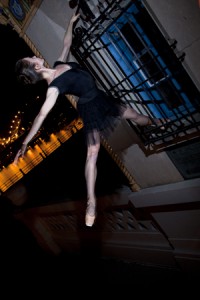by Emily Kate Long
 There’s the saying that if you want to hide something, you put it in plain sight. By dressing her dancers as dolls—wigs, masks, and full-body stuffed suits—Maguy Marin places the un-reality of the fairy-tale as such in plain sight. It is not about a girl and a boy feeling specific things in response to specific events governed by the norms of a specific time and place. Joy in response to love, sadness because of loss, fear of despair and isolation—none of these things are character- or situation-specific to Cinderella. They are simply human, and this staging of Cinderella brings them front and center.
There’s the saying that if you want to hide something, you put it in plain sight. By dressing her dancers as dolls—wigs, masks, and full-body stuffed suits—Maguy Marin places the un-reality of the fairy-tale as such in plain sight. It is not about a girl and a boy feeling specific things in response to specific events governed by the norms of a specific time and place. Joy in response to love, sadness because of loss, fear of despair and isolation—none of these things are character- or situation-specific to Cinderella. They are simply human, and this staging of Cinderella brings them front and center.
Visually, the work is wonderfully strange with plenty of irony and, sometimes, downright silliness. The Sisters and Stepmother are pitifully rude, comic at times and sinister at others. Their torment of Cinderella is violent—thank goodness for the padded costume! Some of the same partnering elements are used later and more gently among Cinderella and the Good Fairies, effectively contrasting the Sisters’ roughness with the Fairies’ care.
Most touching in this work is Cinderella’s awakening solo in Act Three. After attempting to console herself with a broomstick version of her beloved prince, she collapses to the floor in utter despair. Who hasn’t felt so hopelessly wretched upon losing the things most dear to us: love and affirmation?
Marin incorporates play in a very literal way—the Gavotte contains plenty of flat-on-the-back falls for Cinderella as the Good Fairies encourage her to dance, and the ball scene includes guests sliding down the stairs and games of hopscotch and jump-rope. The pas de deux between Cinderella and the Prince features a shy game of paddy-cake and the “airplane,” with her supported off the ground on his feet. All this happens without seeming contrived; the exuberance and joy build naturally. After all, we are dealing with the language of young children, which is widely understood without any words at all.
Also striking about this version of Cinderella was the collision of old-fashioned and futuristic elements. The plaster-face doll masks reminded me immediately of dolls I used to play with at my grandmother’s house. The little girl through whose imagination we witness the story is dressed in vaguely Victorian clothing. Yet, the construction of the dollhouse is minimalist, the Fairy Godmother is an androgynous robot, and Cinderella travels to the Ball in a miniature car. The ballet concludes with a parade of Victorian pull-toys and a clear cellophane film descending as a scrim would. It seals the dolls in their house, as if reminding us that projections and interpretations are just that, real though they may seem. They exist both uniquely for each of us and commonly for all of us.

Assistant Editor Emily Kate Long began her dance education in South Bend, Indiana, with Kimmary Williams and Jacob Rice and graduated in 2007 from Pittsburgh Ballet Theatre School’s Schenley Program. Ms Long attended Milwaukee Ballet School’s Summer Intensive on scholarship before being invited to join Milwaukee Ballet II in 2007. She also has spent summers studying at Saratoga Summer Dance Intensive, Miami City Ballet, Pittsburgh Ballet Theatre School, Pittsburgh Youth Ballet, and Ballet Chicago.
Ms Long has been a member of Ballet Quad Cities since 2009. She has danced featured roles in Deanna Carter’s Ash to Glass and Dracula, participated in the company’s 2010 tour to New York City, and most recently performed the title role in Courtney Lyon’s Cinderella and the role of Clara in The Nutcracker. Prior to joining Ballet Quad Cities Ms Long performed with Milwaukee Ballet and MBII in Michael Pink’s The Nutcracker and Candide Overture, Petipa’s The Sleeping Beauty and La Bayadére, Balanchine’s Who Cares?, Bournonville’s Flower Festival in Genzano and Napoli, and original contemporary and neoclassical works by Tom Teague, Denis Malinkine, Rolando Yanes, and Petr Zaharadnicek.





